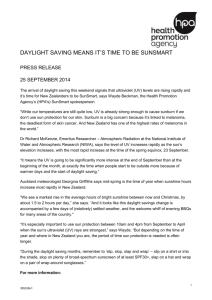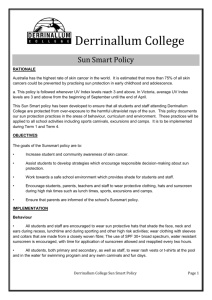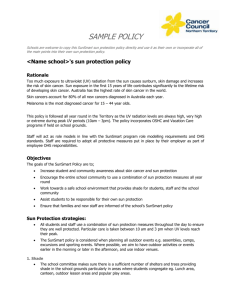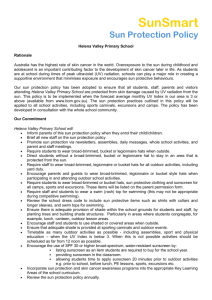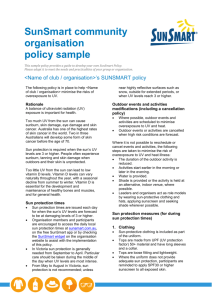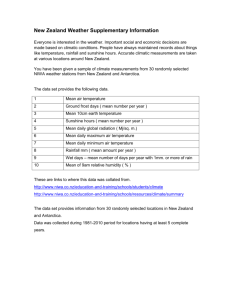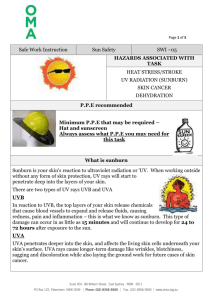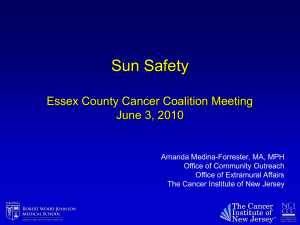2011 archived media releases
advertisement
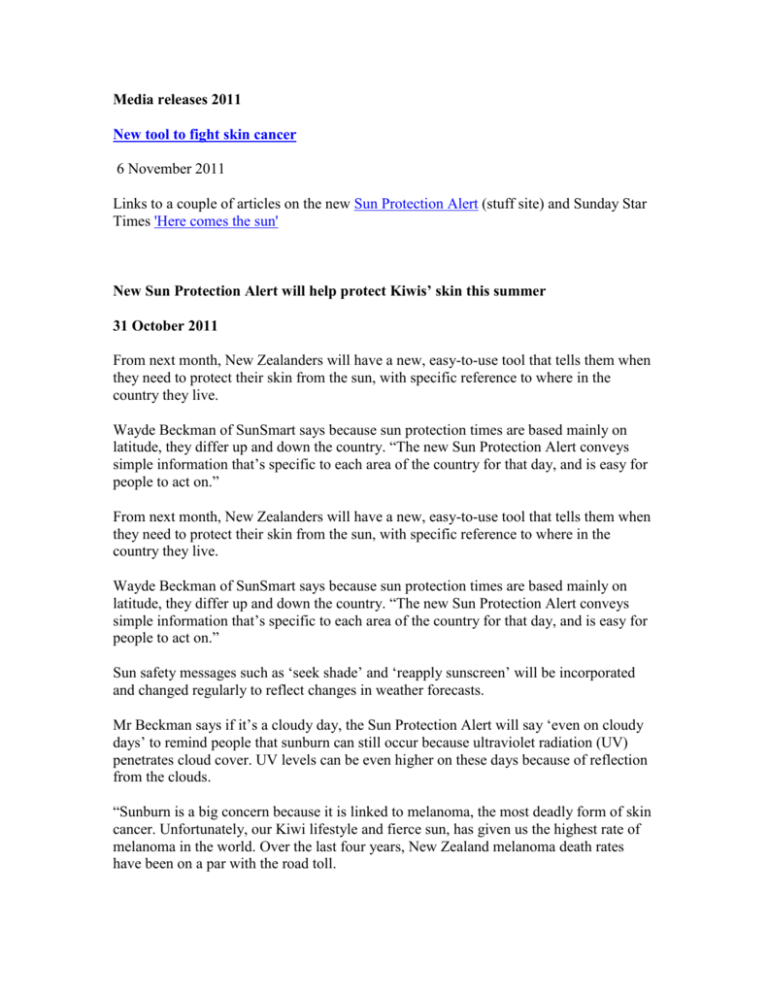
Media releases 2011 New tool to fight skin cancer 6 November 2011 Links to a couple of articles on the new Sun Protection Alert (stuff site) and Sunday Star Times 'Here comes the sun' New Sun Protection Alert will help protect Kiwis’ skin this summer 31 October 2011 From next month, New Zealanders will have a new, easy-to-use tool that tells them when they need to protect their skin from the sun, with specific reference to where in the country they live. Wayde Beckman of SunSmart says because sun protection times are based mainly on latitude, they differ up and down the country. “The new Sun Protection Alert conveys simple information that’s specific to each area of the country for that day, and is easy for people to act on.” From next month, New Zealanders will have a new, easy-to-use tool that tells them when they need to protect their skin from the sun, with specific reference to where in the country they live. Wayde Beckman of SunSmart says because sun protection times are based mainly on latitude, they differ up and down the country. “The new Sun Protection Alert conveys simple information that’s specific to each area of the country for that day, and is easy for people to act on.” Sun safety messages such as ‘seek shade’ and ‘reapply sunscreen’ will be incorporated and changed regularly to reflect changes in weather forecasts. Mr Beckman says if it’s a cloudy day, the Sun Protection Alert will say ‘even on cloudy days’ to remind people that sunburn can still occur because ultraviolet radiation (UV) penetrates cloud cover. UV levels can be even higher on these days because of reflection from the clouds. “Sunburn is a big concern because it is linked to melanoma, the most deadly form of skin cancer. Unfortunately, our Kiwi lifestyle and fierce sun, has given us the highest rate of melanoma in the world. Over the last four years, New Zealand melanoma death rates have been on a par with the road toll. “It is especially important to never let your children get sunburnt. Sunburn in childhood increases the chances of melanoma later in life.” He says skin cancer is largely preventable by taking simple measures to protect ourselves from the sun. “During the daylight saving months, especially between 10am and 4pm, remember to ‘slip, slop, slap and wrap’ – slip on a shirt or into the shade, slop on plenty of broadspectrum SPF30+ sunscreen, slap on a hat and wrap on a pair of wrap-around sunglasses.” And Mr Beckman says there’s no such thing as windburn. “Wind can lower the air temperature though, making it easy to forget that UV from the sun is still strong.” The Sun Protection Alert has been developed in association with the MetService and the National Institute of Water and Atmospheric Research (NIWA) following extensive research, and replaces the UV index. The Sun Protection Alert will be available on the websites of MetService www.metservice.co.nz, NIWA, www.niwa.co.nz and SunSmart www.sunsmart.org.nz, and in most daily newspapers. Mr Beckman says testing of the Sun Protection Alert has shown it motivates people to use sun protection while outdoors. For advice on choosing a sunscreen that will help to protect you from the sun, visit your local community pharmacy. And visit your local Visique store to find a suitable pair of sunglasses. For more information Wayde Beckman, SunSmart Marketing & Communications, HSC on 027 289 6680 The Sun Protection Alert example graphic can be down loaded from the SunSmart website media release section - www.sunsmart.org.nz/media-releases/ . The number one way to fight skin ageing 12 October 2011 What’s tough, elastic, flexible and waterproof - and we each have about 1.8 metres of it? It’s our skin – the largest and one of the hardest working organs in the body. Our skin insulates and protects our body, it can sense five different kinds of stimulation and it helps to control body temperature by distributing heat and preventing dehydration. It also produces hormones and other important chemicals necessary for healthy living. Wayde Beckman from SunSmart says most Kiwis know that New Zealand’s high ultraviolet radiation (UVR) levels mean we have one of the highest rates of skin cancer in the world, but UVR can also cause our skin to age more quickly. “Exposure to UVR can cause noticeable skin changes like age spots, spider veins, rough leathery skin and wrinkles. With repeated exposure, the skin loses the ability to repair itself and becomes thinner – and the damage accumulates. Scientific studies have shown that repeated UVR exposure breaks down collagen and attacks elastin – the protein that keeps skin flexible and non-saggy. “In a nutshell, UV exposure speeds up the skin ageing process. And you thought those wrinkles were about getting older!” He says there are two types of UVR that reach the earth’s surface – UVA and UVB. UVB rays are more likely to cause sunburn, and we know that sunburn can cause melanoma and other types of skin cancers. “But UVA rays pass deeper into the skin, and scientists now think that UVA rays may add to skin damage that can lead to skin cancer and cause premature ageing.” The single most important thing you can do to fight skin ageing is protect your skin from UV exposure, says Wayde, “So slip, slop, slap and wrap, even on cloudy days. “Skin contains melanin, a chemical that reacts to UVR when skin is exposed to sun. The skin attempts to protect itself and cleverly increases melanin levels, resulting in a tan. Unfortunately a tan is a sign that skin damage from UVR has already taken place.” He says UVR also comes from tanning beds and sun lamps, which produce much higher concentrations of UVR than the sun – up to five times as strong as the midday summer sun. “So, if you want a tanned look, get it from a bottle or a spray gun, and take steps to protect your precious, hard working skin this summer. “It is important to use broad spectrum SPF30+ sunscreen on exposed skin, but don’t rely on sunscreen alone. Wear sun protective clothing (shirts with collars and long sleeves), a wide-brimmed hat and sunglasses. It is best to avoid being outdoors during the middle of the day but, if you find yourself outdoors at this time, stay in the shade whenever possible. Your skin will thank you.” And Wayde adds that while the number one way to fight skin ageing is sun protection, the number two way is not to smoke. “Smoking accelerates photoageing by up to 40 percent.” For more information about being SunSmart, contact Wayde Beckman, SunSmart Marketing & Communications, HSC on 027 289 6680. Sun safety experts support better sunscreen standards 31 August 2011 The Health Sponsorship Council (HSC) and the New Zealand Dermatological Society welcome proposed changes to sunscreen standards that would see the SPF limit raised to 50+ (currently 30+) and removal of potentially misleading wording such as “sunblock” and “waterproof”. The Health Sponsorship Council (HSC) and the New Zealand Dermatological Society welcome proposed changes to sunscreen standards that would see the SPF limit raised to 50+ (currently 30+) and removal of potentially misleading wording such as “sunblock” and “waterproof”. These changes are part of a review of the Australian/New Zealand Standard for sunscreen products (AS/NZS 2604:1998). This Standard is used by manufacturers and suppliers of sunscreens here and in Australia, and sets out requirements for the testing and labeling of sunscreens in terms of their sunburn protection factors. Manager of the HSC’s SunSmart programme Laurianne Reinsborough says these proposed changes will provide better consumer protection through improved labeling on sunscreens. The HSC would also like to see the revised Standard require that all labels include advice about reapplying sunscreen at least every two hours and reiterate that sunscreen on its own is not enough. “Using sunscreen is an important part of being safe in the sun but we’d like to remind people to also slip on a shirt and into the shade, slap on a wide brim hat and wrap on close-fitting sunglasses.” Clinical Associate Professor Amanda Oakley, President of the New Zealand Dermatological Society, says that New Zealand has the highest rate of melanoma skin cancer in the world and it’s our fourth most common cancer. In 2008, the Ministry of Health reported 2,256 cases of invasive melanoma and 317 deaths from melanoma in New Zealand. Many thousands of people are also treated for other types of skin cancer such as basal cell carcinoma and squamous cell carcinoma. “Most of these skin cancers could have been prevented by being sun safe. From September to April, use sun protection, especially between 10am to 4pm. Using sunscreen is one way of reducing the risk of getting sunburnt. Changes to the Standard will make it easier for consumers to choose the appropriate product,” she says. ENDS Key contacts for more information Laurianne Reinsborough Dr Amanda Oakley SunSmart Programme Manager President, New Zealand Dermatological Society Incorporated Landline (04) 472 5777 Landline (07) 838 1035 Cell 022 089 2854 Cell 027 271 6985 Email laurianne@hsc.org.nz Email oakley@wave.co.nz Background Health Sponsorship Council The HSC is a Crown agency that promotes health and encourages healthy lifestyles among New Zealanders. As part of its core functions, the HSC operates the New Zealand SunSmart programme. SunSmart The SunSmart programme has been in place since 1993. Its goals are to raise public awareness and promote behavioural change about sun safety. New Zealand Dermatological Society Incorporated Provides authoritative facts about skin diseases, conditions and treatments for consumers, and location listings of dermatologists in New Zealand. Standards New Zealand New Zealand’s leading developer of Standards and Standards-based solutions. It is the operating arm of the Standards Council, an autonomous Crown entity operating under the Standards Act 1988. Standards Australia An independent not-for-profit organisation, recognised by the Australian Government as the key non-government Standards body in Australia. Extra vigilance urged as UV Index reaches extreme levels 27 January 2011 Kiwis are being urged to be extra vigilant with their sun protection in January as the Ultraviolet Radiation (UV) Index reaches extreme levels. Dr Richard McKenzie, Principal Scientist Radiation with the National Institute of Water and Atmospheric Research (NIWA) says the UV Index, which measures UV, is reaching 12 or more in many parts of the country at the moment. “That’s four times the level at which we know we need to take action to protect our skin from damaging UV. “When the UV Index is three or above we need to follow the ‘slip, slop, slap and wrap’ rules. A UV Index above eight is regarded as very high, and ten and above is considered extreme. “So these levels mean we all need to be extra vigilant, especially between 11am and 4pm. More than half of the daily does of UV occurs between those times.” SunSmart’s Wayde Beckman says UV is strongest in New Zealand during the summer school holiday period when people tend to be outside more than usual, but says people shouldn’t be lulled into a false sense of security on cloudy or cooler days. “Even on cloudy days, the UV Index can still be very high.” Wayde says it’s particularly important to ensure children don’t get sunburnt. “Not only is sunburn painful at the time, it increases the risk of developing melanoma skin cancer. Around 300 New Zealanders die from melanoma each year, even though it’s largely preventable by being SunSmart.” NIWA provides daily forecasts of the UVI to the media via MetService, and they are also available at http://www.niwa.co.nz/our-services/online-services/uv-and-ozone/forecasts. Wayde says by following the slip, slop, slap and wrap rules it’s easy to be safe while enjoying the warmer weather and longer days. Slip on some sun-protective clothing, i.e. shirt with a collar and long sleeves, and trousers or long-legged shorts, and slip into some shade wherever possible Slop on SPF30+ sunscreen 15 minutes before you go outdoors and every two hours afterwards. (Note: sunscreen should never be your only or main method of sun protection) Slap on a hat that protects your face, head, neck and ears. Wrap on some sunglasses. Choose sunglasses that cover the whole eye area. For advice on choosing a sunscreen and sunglasses that will help to protect you from the sun, visit your local pharmacy. Ends For further information contact: Wayde Beckman, SunSmart Marketing & Communications, HSC on 027 289 6680
